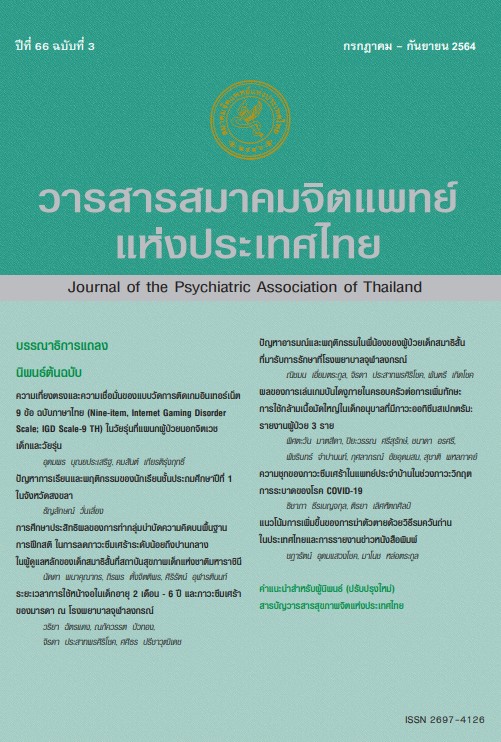The Effects of Playing Snake Ladder Game in the Family to Increase Gross Motor Skills in Kindergarten Children with Autism Spectrum Disorder: A Case Series
Main Article Content
Abstract
Objective: To evaluate and compare the gross motor skill of the kindergarten children (KC) with autism spectrum disorder (ASD) before and during the period of playing snake ladder game (SNG) in the family (according to the pre-set schedule and pattern of playing).
Methods: The participants were specifically selected: must be 4-6 years old and must have a diagnosis of ASD by a child and adolescent psychiatrist. The tools used in this study included (1) the 210 centimeters x 210 centimeters SNG sheet, built by the research team, for playing by the family. The SNG had a playing guideline. Playing instruction included walking, jumping, standing, sitting and crossing. SNG must be played 1 hour/day, 3 days/week for 5 consecutive weeks. At first, playing the SNG was demonstrated by the research team, then the family practiced playing until meeting with the pre-set guideline. Afterward the family continued playing SNG at home. The authors had a regular home visits to observe and regulate the SNG playing at the first, 4th, 8th and the 12th play. (2) questionnaire to interview parents on demographic and clinical characteristics of both participants and their parent(s). (3) The gross motor skill assessment scale which was developed by the research authors. Each playing SNG would occurred after the finishing of each assessment. Two authors alternately assessed the gross motor skill on the morning of Monday, Wednesday and Friday. A total of 19 assessments were included: the first 4 assessments during the baseline period and the 15 consecutive assessments during the intervention period. The results of the study were presented by a raw data (demographic, and gross motor skill score) and single subject design graphs.
Results: Both The SNG and the assessment scale were approved unanimously by 3 ASD experts (one physical therapist, one special education teacher and one child and adolescent psychiatrist) to be sound to the purpose of the research. There were a total of 3 KC participants: one was from the Khon Kaen University Autistic Research Center and two were from Special Education Center 9. Keeping with the schedule and pattern of play, the family SNG play could increase gross motor skills in KC with ASD. The increased motor skill could be sustained throughout the intervention period.
Conclusion: the increase in gross motor skill was due to the appropriate playing, goal directed, and regularly repeated practice. The play was also participated by the family. For the gross motor skill to be progressively enhanced, the family should keep on playing snake ladder game regularly and continually.
Article Details
Articles submitted for consideration must not have been previously published or accepted for publication in any other journal, and must not be under review by any other journal.
References
2. American Psychiatric Association. Diagnostic and statistical manual of mental disorders, fifth edition. Arlington, VA: American Psychiatric Association; 2013.
3. Ming X, Brimacombe M, Wagner GC. Prevalence of motor impairment in autism spectrum disorders. Brain Dev 2007; 29(9): 565-570.
4. Stins JF, Emck C. Balance performance in autism: a brief overview. Front Psychol 2018; 9: 901.
5. Garrido D, Petrova D, Watson LR, Garcia-Retamero R, Carballo G. Language and motor skills in siblings of children with autism spectrum disorder: A meta-analytic review. Autism Res 2017; 10(11): 1737-1750.
6. Kaur M, Bhat A. Creative yoga intervention improves motor and imitation skills of children with autism spectrum disorder. Phys Ther 2019; 99(11): 1520-1534.
7. Yu CCW, Wong SWL, Lo FSF, So RCH, Chan DFY. Study protocol: a randomized controlled trial study on the effect of a game-based exercise training program on promoting physical fitness and mental health in children with autism spectrum disorder. BMC Psychiatry 2018; 18(1): 56.
8. Ashburner J, Rodger S, Ziviani J, Jones J. Occupational therapy services for people with autism spectrum disorders: current state of play, use of evidence and future learning priorities. Aust Occup Ther J 2014; 61(2): 110-120.
9. Palmer KK, Chinn KM, Robinson LE. The effect of the CHAMP intervention on fundamental motor skills and outdoor physical activity in preschoolers. J Sport Health Sci 2019; 8(2): 98-105.
10. Barnett LM, Lai SK, Veldman SLC, Hardy LL, Cliff DP, Morgan PJ, et al. Correlates of Gross Motor Competence in Children and Adolescents: A Systematic Review and Meta-Analysis. Sports Med 2016; 46(11): 1663-1688.
11. Laksana S. Instrumentation. Bangkok: Assumption University of Thailand [Internet]. [cited 2020 Nov 25]. Available from: http://www.education.au.edu.
12. Kaewnam S, Phumma S, Suthat P, Udomkit R. The effect of music movement on gross motor skills of children with Down syndrome in Rajanukul Institute. Bangkok: Rajanukul Institute [Internet]. [cited 2020 Nov 25]. Available from: https://th.rajanukul.go.th
13. Franjoine MR, Gunther JS, Taylor MJ. Pediatric balance scale: a modified version of the berg balance scale for the school-age child with mild to moderate motor impairment. Pediatr Phys Ther 2003; 15(2): 114-128.
14. Jung S, Sainato DM. Teaching play skills to young children with autism. J Intellect Dev Disabil 2013; 38(1): 74-90.
15. Praphatthanakunwong N, Kiatrungrit K, Hongsanguansri S, Nopmaneejumruslers K. Factors associated with parent engagement in DIR/Floortime for treatment of children with autism spectrum disorder. Gen Psychiatr 2018; 31(2): e000009.
16. Fessia G, Manni D, Contini L, Astorino F. Estrategias. Strategies of planned physical activity in autism: systematic review. Rev Salud Publica (Bogota) 2018; 20(3): 390-5.
17. Granpeesheh D, Tarbox J, Dixon DR. Applied behavior analytic interventions for children with autism: a description and review of treatment research. Ann Clin Psychiatry 2009; 21(3): 162-173.
18. Atun-Einy O, Lotan M, Harel Y, Shavit E, Burstein S, Kempner G. Physical therapy for young children diagnosed with autism spectrum disorders-clinical frameworks model in an israeli setting. Front Pediatr 2013; 1: 19.
19. Lammers WJ, Badia P. Inter-Participant Replication. Arkansas: University of Central Arkansas. [Internet]. [cited 2020 Sep 26]. Available from: https://uca.edu/psychology/files/2013/08/Table-of-contents-and-preface.pdf


